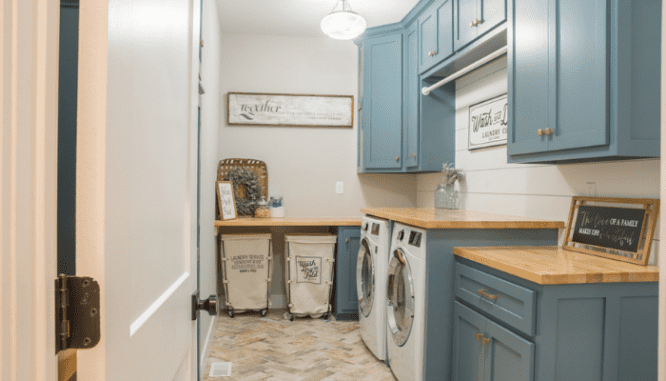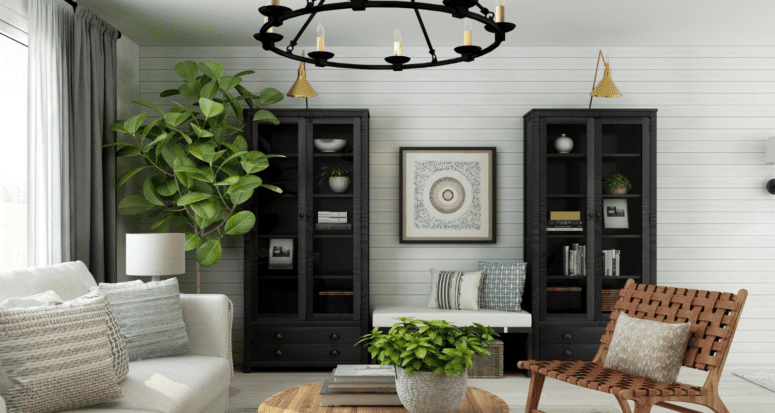The Skinny on Shiplap: Everything You Need to Know to Get the Look
- Published on
- 4 min read
-
 Jenn Andrlik Contributing AuthorClose
Jenn Andrlik Contributing AuthorClose Jenn Andrlik Contributing Author
Jenn Andrlik Contributing AuthorJenn Andrlik has been a journalist for over 20+ years working for such magazines and websites as BHG, House Beautiful, Elle Decor, Martha Stewart, and leading the local magazine Westchester Home for the past six years. She is highly knowledgeable about interior design, architecture, and real estate businesses.
Shiplap is today’s hottest molding trend. Period.
“I’m doing it in in my home currently on my ceilings and walls in my bathroom,” shares Amy Rio, a top real estate agent in Glastonbury, Connecticut with over 34 years of experience selling homes.
“Trim and shiplap are like jewelry on a girl: You’re either plain or dazzling. Shiplap is fabulous!”
Like crown molding, chair rails, and wainscoting, shiplap adds dimension to rooms — giving them a covetable “finished” look. Versatile in design and function, shiplap complements almost every interior design style. Industrial? Check. Modern farmhouse? Check. A beachy cottage? Check. A shiplap accent wall instantly elevates a room. And, best of all, shiplap is relatively easy and affordable to install.
With guidance from Rio and a pro interior designer, we’ll explore the shiplap trend and share everything you need to know to bring this design feature home.

Shiplap’s voyage from high seas to residential homes
As the name suggests, shiplap was originally designed for ships over 1,700 years ago during the times of the Vikings. Shiplap is composed of longboards that overlap tightly, forming watertight siding perfect for ship hulls.
In the early 1900s, homebuilders began using shiplap to strengthen exteriors of seaside properties against the elements. Builders viewed the siding as functional, not stylish, and covered shiplap with wallpaper or drywall. It’s not uncommon for homeowners and designers to uncover shiplap when opening up walls in older homes today.
Shiplap has catapulted to popularity in recent years and is featured in homes around the world and across the Internet. The hashtags #shiplap and #shiplapwalls are trending on social media with 613,012 and 108,078 mentions, respectively.
If you love the look and aren’t lucky enough to uncover old shiplap lurking beneath your walls, have no fear. We’ll steer you through the process of adding a shiplap accent wall to your interior.
Shiplap costs vary by room size and material
Depending on the type of material you use, a shiplap wall can be inexpensive or costly.
| Shiplap material and labor | Average cost |
| Shiplap boards | $2.50 – $7 per square foot |
| Pre-primed MDF boards | $5 – $20 per square foot |
| Installation labor | $1,000+ |
(Source: HomeAdvisor)
“Shiplap cost varies on material, where you purchase, and unfortunately in this climate with the fluctuating cost of lumber in general,” shares designer Megan Oldenburger of Dichotomy Interiors, who boasts over 13 years of interior design experience in Hudson Valley, New York.
According to HomeAdvisor, shiplap boards cost between $2.50 and $7 per square foot. You can also mimic shiplap boards with pre-primed MDF boards (which cost a bit more, ranging from $5 to $20 per square foot depending on size), pinewood planks, or strips of plywood.
“I use both traditional shiplap and pine mostly,” Oldenburger comments. “When I have used pine, I tend to either whitewash or paint it.”
If you use any of these materials instead of true shiplap, you’ll need to precisely space the planks to achieve the look.
Shiplap labor cost
On average, installation costs $1,000 and up per room, depending on the size of the project.
“I’m doing a large room — 10-by-10 — and I’m hiring professionals to install shiplap for around $3,500 with materials,” Rio shares for example. But she adds that many big box stores have DIY instructions for the installation of shiplap walls on their websites. So, if you’re feeling ambitious, you can save on labor by going DIY.
Although it’s less expensive to do-it-yourself, you need to have the right tools (a table saw, stud finder, level, and nail gun) and an entire weekend to build and install a shiplap wall.
Shiplap adds marketability and some value to your home
Will a shiplap wall add value to your home? While there’s no data currently available to answer this question quantitatively, our experts agree that shiplap positively impacts home value.
Rio says that she has seen an increase in value with homes that have trim like shiplap. “I’ve seen a 5% increase in value when a home is decked out in trim,” she notes.
“I think shiplap can add value to the home because it creates a more customized feature rather than generic drywall. Any customization to your home can increase value,” Oldenburger weighs in.
While shiplap may not drastically raise the value of your home, this desirable feature can significantly increase its marketability. Buyers note custom features when comparing properties — your shiplap wall’s beauty may help encourage offers.

Elevate these six rooms with shiplap
“I have used shiplap in the past in a variety of settings,” says Oldenburger. “I have used them anywhere from a living room wall, or an entryway, to a pantry. I like to use them when I want to add texture and dimension to a space without adding a lot of pattern or color.”
Here are styling tips for six spaces to fulfill your shiplap dreams:
Powder room
A small powder room is a perfect place to experiment with shiplap walls without breaking the bank. Rio loves shiplap for powder rooms since the material is just as functional as it is stylish:
“I have a lot of drips in my bathroom from when you run the shower. Shiplap is washable, so you can just wipe those drips off. I am painting mine with marine paint, so it’s extremely water-resistant.”
If your interior styling leans farmhouse or rustic, opt for a distressed finish. Worn-paneling adds a touch of character to your powder room and hides wear and tear.
“Occasionally, I have used more exotic shiplap such as cedar, teak or mahogany in bathroom applications, or when I want to create a warmer, more rustic look,” Oldenburger adds.
Pantry
Much like a powder room, the pantry is typically smaller in scale, making it an excellent place to take a design. Cover every wall with shiplap for a striking, custom finish. To make your pantry items stand out, paint the shiplap in this space a light gray, like Cement Pots by Magnolia Home by Joanna Gaines or Agreeable Gray by Sherwin-Williams.
Mudroom
Shiplap is perfect for protecting mudroom walls that tend to take more beatings than other rooms in the home. Add interest and function by installing hooks, shelves, and cubbies on the paneled wall.
Kitchen
More and more designers and homeowners are using shiplap in the kitchen as a backsplash or island accent, especially in farmhouse and coastal designs. Shiplap works well in the kitchen since it holds up well to grease and food splatters and is easy to wipe clean.
Rio loves painting her shiplap Roman Column by Sherwin Williams. “It’s not a white, white, but a very light pearl,” she says.
Basement
A shiplap is an excellent way to update and brighten a basement. Shiplap complements almost every interior design style, making it a perfect addition regardless of whether you use your den as a man cave, playroom, or home entertainment area.
For a moody atmosphere, paint your shiplap a darker color like Blackboard by Magnolia Homes or Pitch Black by Farrow & Ball.
“My own home, which is modern, has painted black tongue and groove, which creates a graphic look, adding texture and style but in a minimalist way,” Oldenburger notes.
Primary bedroom
Accent walls are trending for primary bedrooms, so slap on some shiplap behind your headboard to get the look. A shiplap accent wall is subtle — especially if you paint it a white like Benjamin Moore’s White Dove — but still makes a statement.
Shiplap is a timeless finish
While shiplap is certainly having a moment in contemporary design, the material is not a trend we expect to come and go. Like crown molding, shiplap is highly versatile and timeless in nature. You can’t go wrong with incorporating this material in your home.
Header Image Source: (Collov Home Design / Unsplash)
